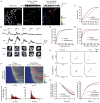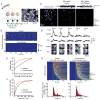Dynamic sensory representations in the olfactory bulb: modulation by wakefulness and experience
- PMID: 23217744
- PMCID: PMC3523713
- DOI: 10.1016/j.neuron.2012.09.037
Dynamic sensory representations in the olfactory bulb: modulation by wakefulness and experience
Abstract
How are sensory representations in the brain influenced by the state of an animal? Here we use chronic two-photon calcium imaging to explore how wakefulness and experience shape odor representations in the mouse olfactory bulb. Comparing the awake and anesthetized state, we show that wakefulness greatly enhances the activity of inhibitory granule cells and makes principal mitral cell odor responses more sparse and temporally dynamic. In awake mice, brief repeated odor experience leads to a gradual and long-lasting (months) weakening of mitral cell odor representations. This mitral cell plasticity is odor specific, recovers gradually over months, and can be repeated with different odors. Furthermore, the expression of this experience-dependent plasticity is prevented by anesthesia. Together, our results demonstrate the dynamic nature of mitral cell odor representations in awake animals, which is constantly shaped by recent odor experience.
Copyright © 2012 Elsevier Inc. All rights reserved.
Figures








References
-
- Adrian ED. The electrical activity of the mammalian olfactory bulb. Electroencephalogr Clin Neurophysiol. 1950;2:377–388. - PubMed
-
- Bathellier B, Buhl DL, Accolla R, Carleton A. Dynamic ensemble odor coding in the mammalian olfactory bulb: sensory information at different timescales. Neuron. 2008;57:586–598. - PubMed
Publication types
MeSH terms
Substances
Grants and funding
LinkOut - more resources
Full Text Sources
Other Literature Sources

